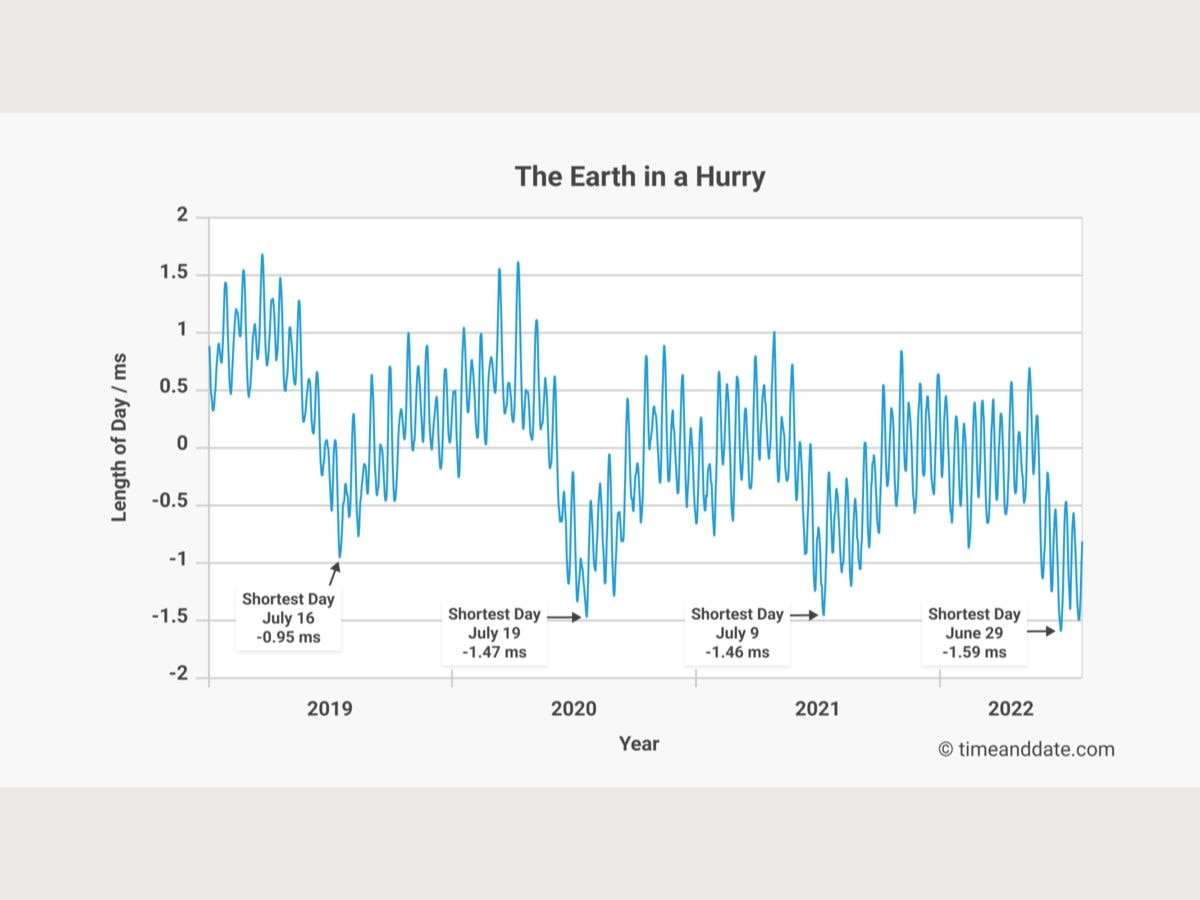Earth's Shortest Day Ever: The Science Behind What Caused It
Earth recorded its shortest day ever on June 29, 2022. Over the last few years, Earth has been spinning on its axis faster than usual, resulting in shorter days. Know the science behind this.

Earth recorded its shortest day ever on June 29, 2022. Over the last few years, Earth has been spinning on its axis faster than usual, resulting in shorter days. But how exactly do we define a day?
The time taken by our planet to complete one spin about its axis with respect to 'fixed stars' is 23 hours 56 minutes and 4.091 seconds. This day is known as the sidereal day.
However, our clocks and calendars are not based on the sidereal day. This is because we have a bigger star nearer to us than other stars, and which significantly impacts our lives — the Sun. When we say there are 24 hours in a day, we are referring to a solar day, which is the time taken by Earth to complete one rotation so that the Sun appears in the same position in the sky.
However, the time required by Earth to complete a solar day changes day to day due to the revolution of our planet around the Sun. In reality, each solar day could either be more or less than 24 hours.
Clocks are based on the average of all the solar days in a year. Thus, on an average, the Earth takes 24 hours to complete one rotation about its axis.
Atomic clocks give the most precise measurement of time. Designed to measure the precise length of a second, atomic clocks have an expected error of only one second in about 100 million years.
Super-accurate atomic clocks were first developed in the 1950s and 1960s, and since then, measurements of Earth's rotation have been made using atomic clocks.
In other words, the solar day on June 29 was 1.59 milliseconds short of 24 hours. June 29, 2022 is the shortest day ever recorded on Earth since the invention of the atomic clock.
The Earth In A Hurry
The International Earth Rotation and Reference Systems Service, the body responsible for maintaining global time and reference frame standards, has released a graph called "The Earth in a Hurry". The graph, shared by timeanddate.com, shows how Earth is spinning faster because of which the days have become shorter from 2019 to 2022.

The shortest day in 2019 was 0.95 milliseconds less than 24 hours. In 2020, the shortest day was 1.47 milliseconds less than 24 hours. This indicates that the shortest day in 2020 was shorter than the shortest day in 2019.
In 2021, the shortest day was 1.46 milliseconds less than 24 hours. The shortest day in 2022 so far was shorter than the shortest day last year.
The graph represents the length of the day in milliseconds on the Y axis and the year on the X axis. One can see that the graph is heading downwards, implying that days are becoming shorter because the "Earth is in a hurry".
The year 2022 saw the shortest day since atomic clocks were invented.
ALSO READ: Earth Spinning Faster, Records Shortest Day Ever. Know Its Impact On Our Clocks
Why Is Earth Spinning Faster?
Each year, the shortest days come in or around July. Movements in Earth's atmosphere and the Moon's orbit around our planet are some of the factors causing Earth to spin faster than usual.
Processes taking place inside the Earth's core, mantle, and on the crust, along with oceans, tides, and climate may be responsible for the downward trend in the length of the shortest day.
According to timeanddate.com, Leonid Zotov and Christian Bizouard from the International Astronomical Union will speak about the 'Chandler Wobble' phenomenon at the 19th Annual Meeting of the Asia Oceania Geosciences Society, timeanddate.com reported. The decrease in the length of a solar day may be related to the Chandler Wobble.
The Chandler Wobble
The Chandler Wobble is a small variation in the rotation of Earth on its axis, resulting in the irregular movement of Earth's geographical poles across the surface of the globe. The phenomenon is similar to a spinning top, the poles of which do not spin in a perfectly straight line.
The Chandler Wobble amounts to a change of about nine metres in the point at which the axis of rotation intersects the surface of Earth, and has a period of 433 days or 14 months.
According to an article published by HowStuffWorks, the Earth's axis of rotation visualised as an imaginary gigantic pen poking through the centre of the Earth, entering at the South Pole and exiting at the North Pole. One can imagine a scratch-pad equipped space station directly over the North Pole. As the Earth completes one rotation, the pen traces a circular point, instead of a dot. This happens because of the "wobble" in Earth's axis of rotation.
American astronomer Seth Carlo Chandler discovered the Chandler Wobble phenomenon in 1891. The Chandler Wobble is one of the main components of the motion of the Earth's rotation axis relative to the Earth's surface, also called Polar Motion, according to a study published in the journal Earth, Planets and Space.
A Chandler Wobble phase jump of about 180 degrees occurred in the 1920s.
Pressure fluctuations at the bottom of oceans are believed to cause changes in the amplitude and phase of the Chandler Wobble over time. Ocean circulation currents, and variations in temperature and salinity result in the pressure changes at the bottom of the oceans.
According to some scientists, tides and the liquid interior of the Earth could also be responsible for the Chandler Wobble phenomenon. It may also be caused by the tidal forces of the Sun.
According to timeanddate.com, Zotov said the normal amplitude of the Chandler Wobble is about three to four metres at the surface of Earth, but from 2017 to 2020, it disappeared.
In 2020, Earth recorded its shortest 28 days since the invention of the atomic clock in the 1960s.
According to the ABC News article, Matt King of the University of Tasmania said Chandler Wobble and the increase in Earth's spin might be linked because both the events can be linked to mass moving around on the surface of Earth.
He explained that some phenomena occurring in the climate system or in the oceans could have caused the Earth to spin faster.
Movements below the surface of Earth can affect the rotation rate of the planet, but these changes occur very slowly.
El Nino And Earthquakes
According to NASA, the Earth's spin can be slowed down by stronger winds in El Niño years. The rotation of the Earth may slow ever so slightly because of stronger winds during El Niño years, NASA said on its website. This increased the length of a day by a fraction of a millisecond.
The word El Niño is used to describe the warming of the sea surface temperature that occurs every few years, and is one of the two terms describing the biggest fluctuation in the Earth's climate system.
When sea temperatures in the tropical eastern Pacific rise five degrees above the long-term average, an El Niño is declared, according to the Met Office.
Meanwhile, earthquakes can increase the Earth's spin. For instance, the 2004 earthquake resulted in a Tsunami in the Indian Ocean, as a result of which enough rock was shifted to shorten the length of the solar day by about three milliseconds.
According to an article published by The Guardian, anything that moves towards the centre of Earth will speed up the rotation of the planet, and geological activity that pushes mass outwards from the centre will have the opposite effect and cause the Earth to spin slower.
What Are Leap Seconds?
Though a few milliseconds do not seem to make any difference, they can add up over the years and cause our clocks to go out of sync with Earth's spin. This is where leap seconds come to the rescue. A leap second can be added or subtracted to modern clocks to synchronise them with Earth's rotation.
The system of leap seconds was introduced in 1972, and so far, there have been 27 leap seconds. A positive leap second adds a second to our clocks, while a negative leap second subtracts a second from our clocks. So far, only positive leap seconds have been used.
The last time a leap second was added to our clocks was in 2016.
What Would Happen If A Negative Leap Second Is Used?
Since Earth is spinning faster than usual, a negative leap second may have to be introduced to make sure that civil time, which is based on atomic clocks, is in step with solar time, which is based on the movement of the Sun across the sky.
However, if a negative leap second is introduced, it would mean that our clocks skip one second, which could create problems for IT systems.
The use of positive leap seconds had created problems in the past. For instance, the use of a positive leap second in 2012 resulted in outages on the social media site Reddit.
In a recent blog post, Meta wrote that the impact of a negative leap second has never been tested on a large scale, and that it could have a devastating effect in the software relying on timers or schedulers. The company also said that in any case, every leap second is a "major source of pain" for people who manage hardware infrastructures.
Meta stated that they believe that the current level of 27 leap seconds will be enough to get us through the next millennium.






































